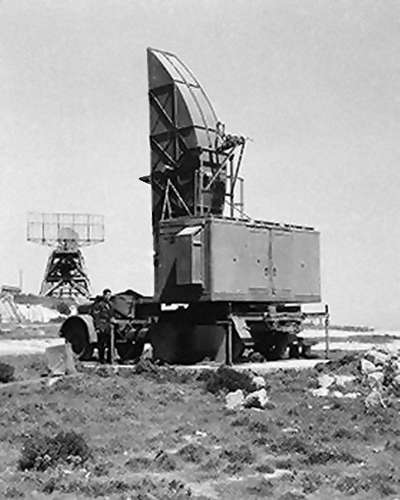Type 13 CMH
Description of the radar set, tactical-technical characteristics

Figure 1: Type 13 CMH height-finder on Malta in World War 2,
photographed by a French soldier
| Specifications | |
|---|---|
| frequency: | S-Band |
| pulse repetition time (PRT): | |
| pulse repetition frequency (PRF): | 500 Hz |
| pulsewidth (τ): | 0.6 or 1.9 µs |
| receive time: | |
| dead time: | |
| peak power: | 500 kW |
| average power: | |
| instrumented range: | |
| range resolution: | |
| accuracy: | |
| beamwidth: | |
| hits per scan: | |
| antenna rotation: | |
| MTBCF: | |
| MTTR: | |
Type 13 CMH
The Type 13 CMH (CentriMetric Heightfinder) was an operating in S-Band nodding height-finder. It was the Royal Air Force's first centimetric radar and was developed in order to improve height information at Ground Controlled Intercept (GCI) radars.
The prototype used two cheese antennas mounted vertically to give an aperture of 20 feet by 3 feet fed by each a H-plane Sectoral Horn. The narrow vertical beam of 1.5° was nodded vertically from -1° elevation to +20° elevation at 6 cycles per minute. The horizontal beamwidth was 7.5°. The display was an E-scope which was used to measure the height of an aircraft using a nomogram.
The development of the Type 13 CMH started in September 1942 and was put into production in March 1943. There have been several modernizations. The first Type 13 Mk II was operational in early 1944. The Type 13 Mk III and IV were similar to the Mk II. The Type 13 Mk V had a much improved antenna using a paraboloid cylinder fed by a slotted waveguide (see Marconi S 239).
